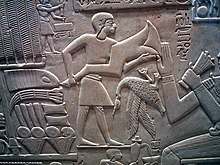|
Foreleg of ox
The Foreleg of ox hieroglyph of ancient Egypt is a hieroglyph; it is the nighttime constellation Ursa Major called as Maskheti constellation. It came to have many uses in ancient Egypt over its entire history. Iconographic usage Offered as "thigh-forward", "meat"One of the major iconographic uses in ancient Egypt of the ox-foreleg was as part of the food offering to the individual being honored (the deceased or living), and engraved upon their steles. Often, besides lying on the top of the pile of food offerings, it is shown being presented to the honored individual, thigh first. Offered as "hoof-forward", "strength"Iconographically used as the symbolism of strength, power, dominion. List of usesA list of uses for the foreleg hieroglyph, with no order of importance actually implied:
Rosetta StoneThough the Foreleg of ox hieroglyph is not used in the Rosetta Stone directly, the strength (khepesh) of the scimitar is. In line R-6: "... and a statue of the god Osiris of the city Alexandria, giving to him, pharaoh Ptolemy V, a 'royal sword' (khepesh nesu) of victory";[1] the word khepesh uses the scimitar hieroglyph as the determinative. The quote is part of the ten rewards to be given to Pharaoh Ptolemy V in the Rosetta Stone.
See also
References
Wikimedia Commons has media related to Leg of cow (hieroglyph).
|
